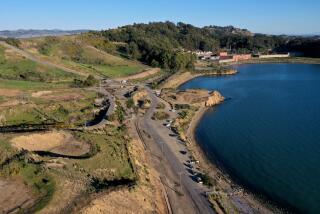Developers, Historians at Odds Over Manassas Site : A Century Later, New Battle of Bull Run Rages
- Share via
MANASSAS, Va. — They’re calling it the third great battle of Manassas.
It was here, in the rolling hills and open fields overlooking Bull Run creek, that 35,000 cocksure Union troops were routed in July, 1861, by a surprisingly strong Confederate force in the first battle of the Civil War. A year later, Confederate Gen. Thomas J. (Stonewall) Jackson reputedly earned his nickname in another major clash on the site.
And it is here that preservationists, Civil War buffs and a growing number of national figures are now waging their own pitched battle to block plans for a 1.2-million-square-foot shopping mall to be built next to what is now Manassas National Battlefield Park.
The growing furor in this area 26 miles west of Washington has spilled past its wooded boundaries, drawing Rep. Morris K. Udall (D-Ariz.), former Carter White House Press Secretary Jody Powell and others into a controversy that could have national implications in the debate over development and the often conflicting cause of historic preservation.
‘A Bombshell’
“Of all the terrible things that could have happened to this place, this is the worst--a bombshell,” says Brian Pohanka, a Civil War historian who donned Union military garb over the weekend to take part in one of the periodic battle re-enactments at the site.
Pohanka describes the prospect of a regional mall in Manassas, looming on a hill over the site that draws 700,000 visitors a year, as a desecration of “hallowed” ground.
“Rare is the place where two great battles were fought on the same ground,” he said. “The land still looks much as it did in the war. It’s a very special place.”
The modern battle was engaged in January when developers Hazel-Peterson Cos. and the Edward J. DeBartolo Corp. announced plans for a shopping, commercial and residential complex designed to tap into a rapidly growing region just outside the capital city’s suburban sprawl. The project would be on 600 acres next to the battlefield and would include the spot where Gen. Robert E. Lee made his headquarters in the second battle of Manassas.
Symbol of Fragility
Since then, angry opponents have circulated petitions, begun preparing a lawsuit and appealed to members of Congress for legislation to require large buffers between developments and such historic sites nationwide. So far the effort has not blocked the project, but the opponents say they are still optimistic that it will prove successful eventually. In the process, they say, they hope to make Manassas a symbol of the fragility of such sites to intrusion.
The developers are promoting the project as a symbol of needed economic growth. They have said the mall and office buildings, which could be completed by 1992, will prove a financial boon to the more than 200,000 residents of Prince William County, providing up to 2,900 jobs and millions of dollars in sales tax revenues in the next two decades.
They have won the support of some county government leaders, who complain that the area’s federal lands put a serious strain on the county tax base.
Those officials also maintain that the development would be attractive and the atmosphere of the park would not be violated. The site plans are being reviewed by a county board.
‘Path of Bullet’
County Atty. John Foote, defending the plans, speaks with an air of inevitability about development of the area. With Washington growing, the county finds itself “in the path of a speeding bullet,” Foote contended, “and we’re powerless to stop it.”
But opponents of the mall project are not convinced of that. Banded together as the Save the Battlefield Coalition, they are pressing their case that the complex would leave irreparable scars on a community that considers its battlefield a national and community treasure. They forecast traffic snarls, a view destroyed and the battlefield’s historical, mystical air forever changed.
Oswald Johnson, a 78-year-old retired principal whose ancestors worked the land around Manassas as slaves 125 years ago, can look out his window at the site of the mall, now an open field, and envision the paved lots and rows of stores and condominiums. “I can see it and smell it and hear it, and I abhor the thought,” Johnson said.
Fifth-grader Jessica Boyers has collected 542 signatures from schoolmates on a protest petition. Coalition attorneys are drafting a suit that would challenge the zoning for the area.
The opponents have partly succeeded in making their dilemma a national issue. Powell, now a public relations executive in Washington, has agreed to represent the coalition for free and Udall participated in an “inspection” of the park Saturday.
Udall, who heads the House Interior and Insular Affairs Committee, said he agreed there is “a national problem” posed by the clash of development and historic sites and promised his committee would review measures to protect the parks.
If they lose, said Civil War buff Pohanka, “no national park in the country is safe. Someone could build a skyscraper next to Yellowstone if they want.”
More to Read
Sign up for Essential California
The most important California stories and recommendations in your inbox every morning.
You may occasionally receive promotional content from the Los Angeles Times.









